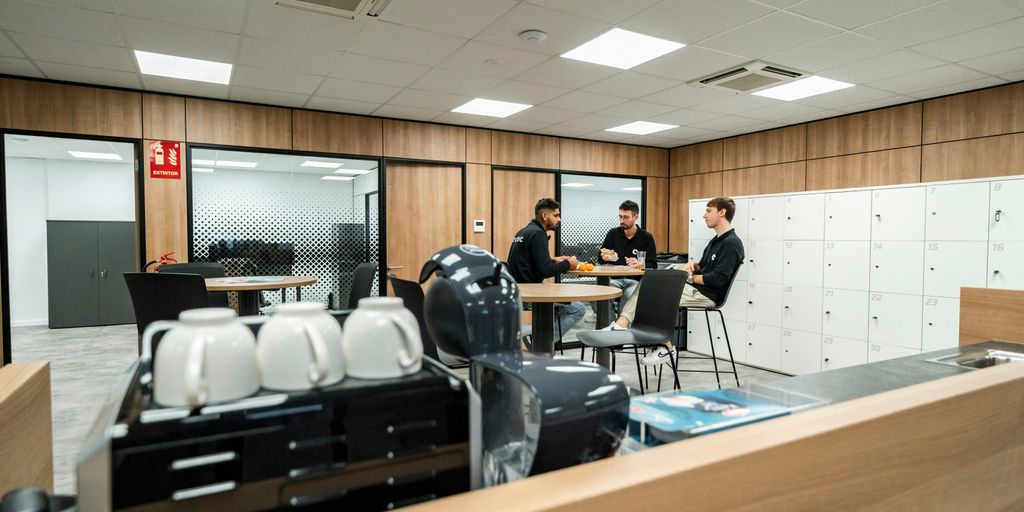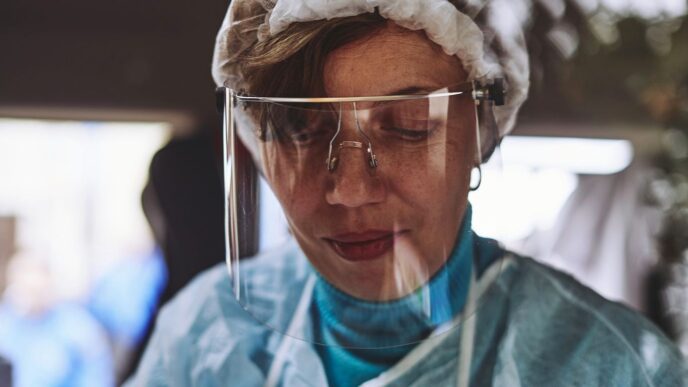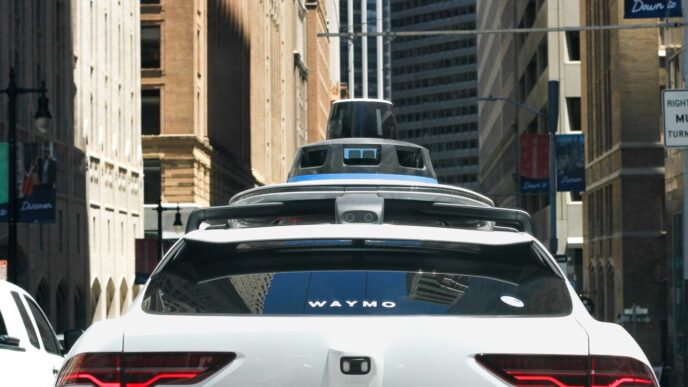It seems like everyone’s talking about virtual reality for training these days. Companies are looking for new ways to get their employees up to speed, and VR is popping up as a solution. Think about it – instead of just reading a manual, you can actually *do* the task in a simulated environment. We’re seeing how this tech, especially through companies like Strivr, is changing how people learn and perform at work. It’s pretty interesting to see how it all plays out.
Key Takeaways
- Strivr uses VR to create realistic training scenarios, helping employees learn by doing.
- VR training can lead to better job performance and make skills stick through muscle memory.
- The immersive nature of VR makes learning more engaging and improves how much people remember.
- Companies can use VR for safe practice, especially for high-risk jobs or rare situations.
- Strivr’s approach combines VR with data insights to help track progress and improve training over time.
Revolutionizing Workforce Training with Strivr
Elevating Corporate Training with Immersive VR
The way companies train their staff is changing, and Virtual Reality (VR) is leading the charge. Forget boring lectures or dry manuals; VR throws people right into the action. It puts them in realistic situations where they have to do the job, not just read about it. This makes learning way more interesting. Think about it: instead of just hearing about how to handle a difficult customer, you can actually practice it in a safe, virtual space. This kind of hands-on experience, even if it’s digital, really sticks with people. It’s a big step up from just watching a video. Companies are seeing that this approach helps employees learn faster and remember more.
The Tangible Benefits of VR in Professional Development
So, what does this actually mean for businesses? Well, for starters, people learn better. Studies show that VR learners remember about 75% of what they experience, which is a huge jump compared to other methods. This means less time spent re-teaching and more time being productive. Plus, it’s safer. Employees can practice using heavy machinery or dealing with emergency situations without any real-world risk. This builds confidence and competence. It also means training can be done anywhere, anytime, making it easier to get everyone up to speed, no matter where they are located. It’s a smart way to invest in your team’s skills.
Strivr’s Approach to Immersive Learning
Strivr gets this. They’re not just throwing VR headsets at people; they’re building training programs that are designed from the ground up for this technology. They focus on creating scenarios that are as close to real life as possible, so when employees go back to their actual jobs, they’re already prepared. They figure out what skills are most important for a job and then create VR experiences to practice those specific things. It’s about making the learning practical and directly useful. They also understand that VR works best when it’s part of a bigger training plan, not just a standalone gimmick. It’s about using the right tool for the right job to build a more capable workforce.
Enhancing Employee Performance Through Strivr’s VR

Measurable Improvement in Employee Performance
It’s not just about feeling more confident after a VR session; the results are actually trackable. Companies using Strivr’s VR training have seen real jumps in how well employees do their jobs. Think about it: when you practice something over and over in a safe, virtual space, you get better at it. This isn’t just a feeling; it’s backed by data. Organizations can look at specific numbers to see how much people have improved, which helps them figure out what’s working and what could be tweaked in the training itself. It’s a way to keep making the training better and better.
Real-World Application and Muscle Memory Development
One of the coolest things about VR is how it lets people practice real job tasks without any of the usual risks. When you do something repeatedly in a VR simulation, your brain and body start to remember it. It’s like building muscle memory. This means when you’re actually on the job, performing that task, it feels more natural and you’re less likely to make mistakes. This kind of practice is super helpful for jobs that involve a lot of hands-on work or require quick thinking in tricky situations. It’s about getting people ready for what they’ll actually face.
Maximizing Knowledge Retention with Immersive VR
Virtual reality workshops are really good at helping people remember what they learned. Because the experiences are so engaging and hands-on, the information sticks better than just reading a manual or watching a video. When you’re actively involved in a scenario, you create stronger memories. Studies suggest that learning through VR can improve how much people remember by a good amount compared to older methods. This is because VR uses more of your senses, making the learning experience more memorable and easier to recall when it’s actually needed.
The Strivr Advantage: Engaging and Effective Learning

Engagement That Powers Learning
Let’s be honest, sitting through a long training session can be a drag. Strivr’s approach changes that. By dropping employees into realistic, virtual scenarios, it grabs their attention. It’s not just watching; it’s doing. This active participation means people actually remember what they learned. Think about it: PwC found that VR training can boost emotional connection to the material by 75% compared to just reading or watching something online. That’s a big difference when you want your team to really absorb the information.
Safe Practice Environments for Skill Acquisition
Some jobs require hands-on practice, but messing up can be costly or even dangerous. VR offers a solution. It lets people try out new skills, like operating complex machinery or handling difficult customer interactions, in a space where mistakes don’t have real-world consequences. This means your team can build confidence and get a feel for the task without risking damage to equipment or causing customer issues. It’s a great way to get ready for the real thing, building that muscle memory before it counts. This kind of practice is especially useful for roles in fields like advanced manufacturing.
Scalable Solutions for Global Workforces
Training a large team, especially one spread across different locations, can be a logistical headache. VR training is designed to be scaled up easily. Once a program is built, you can deploy it to hundreds or even thousands of employees without needing to book training rooms or fly in instructors. This makes it a really efficient way to get consistent training to everyone, no matter where they are. It cuts down on travel costs and time away from the job, making the whole process more economical and straightforward for businesses of all sizes.
Integrating Strivr’s VR into Your Training Strategy
So, you’ve decided to bring Strivr’s virtual reality training into your company. That’s a big step, and a smart one if you’re looking to really change how your team learns and performs. But how do you actually make it work? It’s not just about buying the headsets; it’s about fitting it into your existing training plans so it actually helps.
Actionable Tips for Successful VR Training Integration
Getting VR training set up right takes some thought. You don’t want it to be just another thing people do; you want it to be effective. Here are a few pointers to get you started:
- Pinpoint the right skills: Figure out which job tasks or skills would genuinely benefit from VR practice. Think about things that are hard to replicate safely or cost-effectively in real life, like handling complex machinery or dealing with emergency situations. This is where VR really shines.
- Make it real: The virtual scenarios need to match what your employees actually do on the job. The closer the simulation is to reality, the better they’ll be able to transfer that learning back to their daily tasks. It’s about building that muscle memory and confidence.
- Keep it consistent: Don’t just do a one-off VR session. Regular, scheduled training sessions will help reinforce the skills and make the learning stick. Think of it like practicing a musical instrument; consistent practice leads to mastery.
Combining VR with Traditional Hands-On Training
VR isn’t meant to replace everything you’re already doing. Instead, think of it as a powerful addition to your current training methods. You can use VR for the initial learning and practice, especially for those tricky or high-risk tasks. Then, follow up with real-world, hands-on sessions where employees can apply what they’ve learned in the virtual space. This combination approach gives people a well-rounded learning experience, bridging the gap between theory and practice. It’s about creating a more complete training program that covers all the bases.
Mapping Skills and Scenarios Best Suited for VR
Not every training need is a perfect fit for VR. You need to be strategic about where you deploy it. Start by looking at your current training programs and identifying areas where employees struggle or where mistakes can be costly. For example, if your team needs to learn intricate repair procedures or practice customer service interactions in difficult situations, VR can provide a safe and repeatable environment for them to hone these skills. It’s also great for onboarding new employees, giving them a realistic preview of their work environment and tasks. By carefully mapping out which skills and scenarios are most appropriate for VR, you can make sure your investment yields the best possible results and supports AI-powered workflows.
Measuring Success and Continuous Improvement with Strivr
So, you’ve got your VR training up and running with Strivr. That’s great, but how do you know if it’s actually working? It’s not enough to just put people in headsets; you need to see if it’s making a real difference. Tracking progress and getting feedback are key to making your VR training even better over time.
Employing Pre- and Post-Training Assessments
One of the most straightforward ways to see if the training is sticking is by using tests. You can give employees a quiz or a practical task before they start the VR program and then again after they finish. This helps you see what they’ve learned and where they might still need some help. It’s like checking your homework before and after you study.
Collecting Detailed Participant Feedback
Don’t forget to ask the people who went through the training what they thought. Were the scenarios realistic? Was the VR easy to use? Did they feel more confident afterward? Gathering this kind of feedback is super important. You can use surveys or just have informal chats. It gives you the inside scoop on what’s working and what’s not.
Leveraging AI-Driven Performance Insights
Strivr’s platform can also give you deeper insights. It’s not just about passing a test; it’s about how well people perform tasks. The system can track things like how quickly someone completes a virtual task, how many mistakes they make, or even their reaction times. This data, often powered by AI, can show you specific areas where employees are improving or where the training might need a tweak. It’s a good way to get a clear picture of the return on investment for your training efforts.
Strivr’s Impact: Industry Leaders and Success Stories
It’s always interesting to see how big companies are using new tech, right? Strivr has really made a name for itself by helping major players train their staff in ways that just weren’t possible before. Think about Walmart, for example. They’ve been using Strivr’s virtual reality programs to get their associates ready for all sorts of situations. It’s not just about learning where things are in the store; it’s about practicing how to handle customer questions, manage inventory, and even deal with unexpected events.
Walmart’s VR-Based Immersive Training Program
Walmart rolled out VR training to thousands of its stores. The idea was to give employees hands-on experience in a safe, virtual space. They could practice things like opening a new store, dealing with busy holiday rushes, or learning new technology without any real-world pressure. This kind of practice helps build confidence and makes sure everyone knows what to do when it actually happens. It’s a smart way to prepare people for the job.
Strivr’s Role in Enhancing Associate Readiness
What Strivr does is create these realistic scenarios that mimic the actual work environment. For Walmart associates, this means they can practice customer interactions, learn how to use new equipment, or even go through safety drills. The virtual reality setup lets them repeat tasks until they get them right, which is great for building muscle memory and making sure the training sticks. It’s a big step up from just reading a manual or watching a video. Companies like Sprouts Farmers Market are also using these kinds of platforms to help new hires get up to speed quickly. See how Sprouts uses VR.
The Future Potential of VR in Professional Development
Looking ahead, it’s clear that VR training is going to be a bigger part of how companies develop their employees. The ability to simulate complex or dangerous situations safely means that people can learn and improve without risk. This not only makes training more effective but also more engaging. As the technology gets better and more accessible, we’ll likely see even more industries adopting VR to train their workforces, leading to better performance and more skilled employees across the board.
The Future of Training is Here
So, what does all this mean for companies looking to get their employees up to speed? Basically, VR training, like what Strivr is doing, is a really smart way to teach new skills. It lets people practice things over and over in a safe space, which helps them remember better and get ready for the real job. It’s not about ditching old training methods entirely, but adding something new that makes learning stick. By using VR, businesses can build a team that’s ready for whatever comes next. It’s a big step forward, and honestly, it just makes sense for companies wanting to invest in their people and stay ahead.
Frequently Asked Questions
What exactly is VR training?
Virtual Reality (VR) training uses special headsets to put you in a simulated world. It’s like stepping into a video game but for learning real job skills. This makes training more fun and helps you remember things better because you’re actually doing them.
How does VR training help me do my job better?
VR helps you learn by doing. Imagine practicing how to handle a difficult customer or fix a machine without any real-world consequences. This practice builds confidence and makes you better prepared for when these situations happen for real.
Why do companies use VR for training?
Companies use VR because it makes learning more engaging than just reading or listening. It’s like being in a movie where you have to make choices. This helps people pay attention and remember what they learned much longer.
Is VR training safe for practicing risky tasks?
Yes, VR training is great for practicing skills safely. You can try things that might be dangerous or hard to set up in real life, like using special equipment or dealing with emergencies, over and over again until you get it right.
Can you give an example of a company using VR training successfully?
Many big companies like Walmart are using VR to train their employees. They found that people trained with VR get better at their jobs and make fewer mistakes. It’s a proven way to improve how well employees perform.
How does VR training fit with other types of training?
Think of VR training as an extra tool to help you learn. It works best when combined with regular, hands-on training. This mix helps you understand the ‘why’ and ‘how’ of your job really well.














